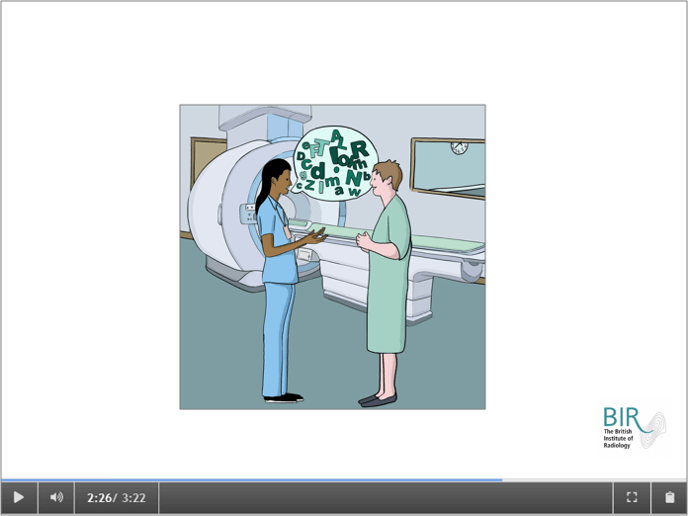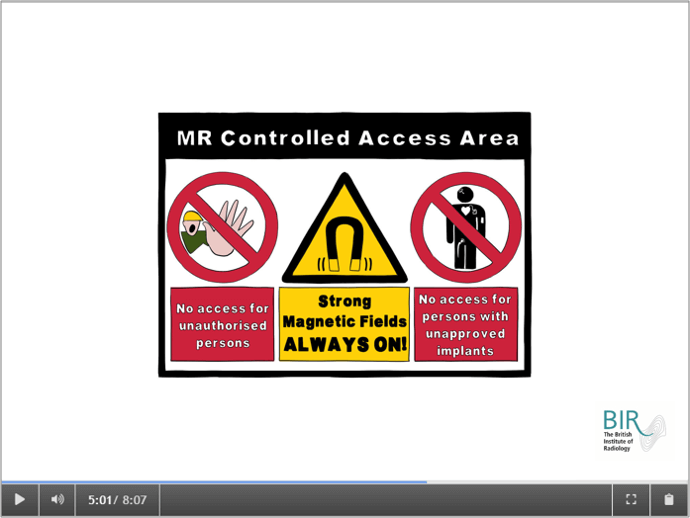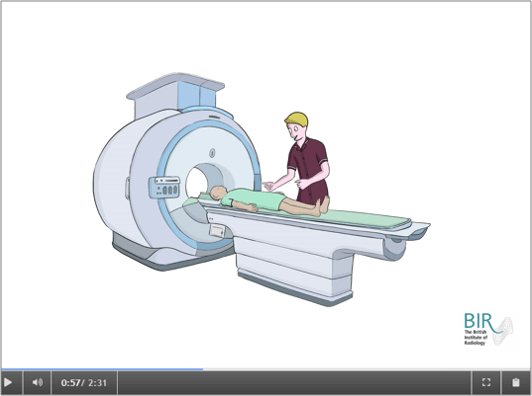
This course is essential for all members of the imaging and radiation oncology team including radiographers, radiologists, oncologists, physicists, technicians, technologists and others.
"Wow, it is fantastic!" Cath Mills, Clinical Lead Radiographer, Circle Health Group.
What do people say about the course? More testimonials here


This course will enable you to fulfil your MRI responsibilities safely and effectively. Upon completion of this course you will have an understanding of the MRI unit and contrast used in MRI scanning, as well as correct practice for patient preparation and scanning.
- Three hours of video divided into digestible sessions, with test questions throughout and an assessment at the end, awarding a CPD certificate
- Content includes illustrations, animations, live action, and recorded interviews, with narration providing clear explanation at every step
- Stop and start as you wish with up to one year to complete the course
- Written by some of the UK’s foremost MRI professionals working in clinical settings, peer reviewed, and with contributions from leading experts
- Uses proven educational techniques to make it engaging and memorable
- Relevant to the practical needs of busy professionals.
This course provides 4 CPD credits in accordance with the CPD Scheme of The Royal College of Radiologists, and has been approved for professional accreditation by the College of Radiographers until June 2027.



Course sections
Section 1: Introduction to the course and MRI
This section gives an overview of what will be covered in the course and explains why MRI is different to other imaging modalities in terms of how the signal is generated. The limitations and advantages of MRI are also covered.
Section 2: The MRI unit
The layout of a typical MRI unit is explained in this section, including design features that ensure safe and effective working. The role of the Operator in keeping the environment safe is also covered, as well as how to control access to MR controlled access area and the MR environment. The patient’s journey through the MRI department is also described along with the different roles and responsibilities of the MR Responsible Person, the MR Authorised Person and the MR Safety Expert.
Section 3: Preparing to welcome the patient
This section covers the typical process of welcoming a patient to the MRI department and preparing them for their scan. Radiofrequency burns and methods to avoid them are described, as well as the importance of screening patients in relation to MR safety. MRI accessories and equipment are also described along with correct labelling for use in an MRI department.
Section 4: The patient journey to the MRI unit
Patient referral and patient screening are covered in detail in this section, including how to check for implants, devices or contraindications, how to assess the patient and explain the scan process including any preparation, and finally when adaptive practice may be required. Preparing and positioning the patient for their scan are also covered in this section, including how to adapt the set-up depending on patient needs and department facilities.
Section 5: Scanning
This section covers the scanning process and describes key factors that determine pulse sequence choice as well as any additional considerations when setting up a sequence. Pulse sequence choice considerations covered include spin echo family versus gradient echo family, desired weighting, and breath-holds.
Section 6: Contrast and other medicines used in imaging
In this section, contrast agents and other medicines typically used in MRI are covered, along with safety considerations relating to their use. MRI contrast agent risk factors, safety screening, likelihood and management of acute adverse reactions, and pregnancy and breast feeding considerations are discussed.
Section 7: Ending the examination
This section covers how to correctly end an MRI examination. This includes bringing the patient out of the scanner and any aftercare including post-contrast or other drug care. How to evaluate MRI images is also covered in this section, such as checking the patient details are correct, checking correct weighting, coverage, whether there is sufficient resolution and no avoidable artefacts, or whether the scan needs to be repeated. Post-processing is also covered.
Section 8: Troubleshooting
Common artefacts and strategies to minimise them are described in this section.
Section 9: Running the MR suite and managing adverse situations
This final section of the course goes through some steps to maintain a safe MRI department such as infection control and cleaning schedules and safe storage of coils. Emergency procedures are also covered including when and how to use the Quench, electrical shutdowns, fire procedures, security procedures and cardiac arrest procedures.
What people say
"I like the inclusion of actually working through the patient journey and radiographer journey through a scan. That’s not something I’ve really seen before." Trudi Whitehead, MRI Responsible Officer and Superintendent Radiographer (Non-Ionising Radiation), Royal Derby Hospital.
"This is an excellent course. It is really well produced and presented, a very professional job." Professor Stephen Keevil, Head of Medical Physics, Guy’s and St Thomas’ NHS Foundation Trust.
What do people say about the course? More testimonials here
Contributors
Course Directors: Rachel Watt (Locum MRI Radiographer, Jersey General Hospital) and Matthew Clemence (Senior Scientist MRI, Philips Healthcare).
Expert Panel: Christine Heales (MRI Lead Radiographer, University Hospitals Plymouth NHS Trust and Lecturer, University of Exeter), Helen Estall (MRI Consultant Radiographer, University Hospitals Leicester) and Cath Mills (Clinical Lead Radiographer, Circle Health Group).
Interviewees:
Professor Stephen Keevil (Head of Medical Physics, Guy’s and St Thomas’ NHS Foundation Trust), Professor Martin Graves (Consultant Clinical Scientist and Head of MR Physics and Radiology IT, Cambridge University Hospital), Geoff Charles-Edwards (Consultant Clinical Scientist and Head of MR Physics, Guy's & St Thomas' NHS Foundation Trust), Alexandra Lipton (Professional Officer, Senior Service Managers and Cross Sectional Imaging Lead, The Society and College of Radiographers), Matthew Clemence (Senior Scientist MRI, Philips Healthcare), Helen Estall (MRI Consultant Radiographer, University Hospitals Leicester), Cath Mills (Lead CT/MRI Radiographer, BMI Healthcare) and Maria Schmidt (Clinical Scientist, The Royal Marsden NHS Foundation Trust).
Price
Standard rate: £89.99
BIR member rate: £75.99
Prices are for a 12 month licence to view video content and complete the test. Course transcript, user notes and CPD certificate can be downloaded and kept indefinitely.
Still not sure? Check out our Frequently Asked Questions